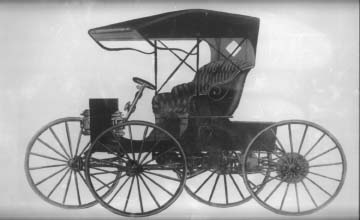| | mph, but a more realistic cruising speed was about 15 mph. Highwheeler automobiles were a short-lived phenomena, with demand running from about 1907 to 1911. It is likely that approximately 100,000 highwheelers were built. At the peak of highwheeler popularity in 1909 there were 41 major, nationally known makes of highwheelers. This is up from 15 in 1907, and 31 in 1908. By 1910, it had fallen to 24, and then down to 9 makes in 1911. DeWitt Motor Vehicle Company would not have been counted among the major makes Contrary to popular belief, highwheelers were not the most common type of automobiles in the very early days of motoring. The earliest cars quickly evolved into elaborate and expensive playthings of the wealthy. Highwheelers evolved out of a demand for cheap practical cars that ordinary people could afford, and that could be drive out in the farm country of the midwest over the incredibly bad roads of the period. Highwheelers became obsolete as road improved and pneumatic-tired cars became more practical (Model T Ford, for example). Kiblinger, of Auburn, IN, was one of the predominant manufacturers of highwheeler automobiles. This company was a major manufacturer of buggies and wagons in the late 1800's and progressed into automobiles. In about 1909, the firm changed ownership, and the name changed to McIntyre. McIntyre produced a myriad of models of motor vehicles, ranging from simple highwheelers, to luxury pneumatic-tired automobiles, to commercial trucks. Mr. Virgil DeWitt was a Swedish immigrant who ended up settling in Auburn, IN. He married an Auburn woman and was associated with the Kiblinger company, and later, the McIntyre company. As the boom in highwheeler cars got underway, Virgil DeWitt arranged to build a manufacturing facility in North Manchester and produced at least two models of highwheelers under the name of DeWitt Motor Vehicle Company. The DeWitt vehicles were virtual copies of McIntyre vehicles. The engine, mechanism, and chassis appear to be identical to McIntyre models, with perhaps minor differences in bodies and accessories. In fact, Mr. W. H. McIntyre was the major stockholder of the DeWitt Motor Vehicle Company. | |
